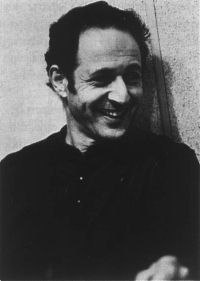
Reich’s early works were created in the early 1960’s at the San Francisco Tape Music Center. These tape pieces, such as "It’s Gonna Rain" (1965) and "Come Out" (1966), are the earliest examples of "phasing," one of Reich’s most used and most well known techniques. In this process, two tape loops are set into motion at two slightly different speeds, so that the tapes begin in unison and slowly shift "out of phase," creating a new set of harmonies and rhythms. This process was later incorporated into several pieces for traditional acoustic instruments (or instruments and tape), such as in "Piano Phase" (1967) and "Violin Phase" (1967). In addition to the initial process of phasing, Reich also introduces into "Violin Phase" the notion of "found" or "resulting" patterns (new melodic figures created from the overlapping voices of the original "theme").
This technique was further explored in the largely popular and influential "Drumming" of 1971. In 1970, Reich set out on an intensive study of Ghanaian drumming that, either directly or indirectly, led to many of the procedures used not only in "Drumming" but also throughout the remainder of his career. This piece is an enormous, hour-long elaboration of a single rhythmic cell, developed and re-orchestrated through four distinct sections. The piece begins with a slow, additive process of introducing the initial rhythmic pattern. Through phasing procedures and further "build-up and reduction," new melodic and harmonic patterns are created—these are brought to the fore by doublings, first by female voice, then by whistling, and finally by piccolo.
Reich’s later music is characterized by a considerably faster harmonic rate of change, and by a more diverse (though still strictly diatonic) harmonic language. In the mid to late 1970’s, a series of commissions from ensembles other than his own (up until this point, Reich’s ensemble was the sole performing group for his music) led to several non-percussion works; "Music for 18 Musicians" (1976), "Music for a Large Ensemble" (1978) and "Octet" (1979) all came in this period.
Recently, Reich has returned to the ideas first seen in "Violin Phase" in a series of pieces for solo instruments and tape. "Vermont Counterpoint," for flute, "New York Counterpoint," for clarinet, and "Electric Counterpoint" for electric guitar, build upon the original processes of the early phasing music. The complexity, however, is far deeper than the early phasing pieces: In Vermont Counterpoint, for example, a total of 10 layers are prerecorded, with the final 11th flute layer played live.
Reich has also recently returned to the voice, as in "Tehillim" (1981), a setting of Psalm texts in Hebrew, "Different Trains" (1988) for string quartet and tape, and in Reich’s hugely successful venture into the theater, "The Cave" (1990-3). Each of these works explores the pitch of taped and sequenced voices, and then uses those pitches as melodic material in the accompanying instrumental ensemble.
Reich’s combination of repetition and process creates a music full of vitality and energy. His strict, tonal melodic style has brought Reich much critical acclaim, even in a general public that often is distrustful of "new music." As such, Reich has, in many ways, led a charge toward establishing the accessible and almost "anti-academic" diatribe of the newest developments in contemporary music.
(see article on Minimalism)
(hear Nagoya Marimbas)